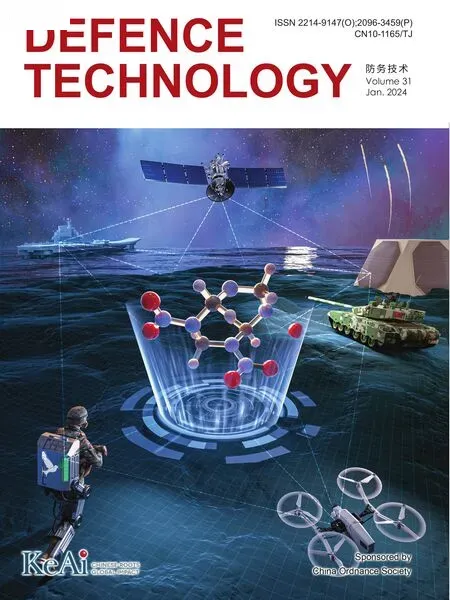The interaction between a shaped charge jet and a single moving plate
Andreas Helte, Jonas Lundgren, Jonas Candle
FOI, Weapons, Protection and Security, SE-164 90, Stockholm, Sweden
Keywords: Reactive armour Flyer plate Shaped charge jet
ABSTRACT Reactive armour is a very efficient add-on armour against shaped charge threats.Explosive reactive armour consists of one or several plates that are accelerated by an explosive.Similar but less violent acceleration of plates can also be achieved in a completely inert reactive armour.To be efficient against elongated jets, the motion of the plates needs to be inclined against the jet such that a sliding contact between the jet and the plates is established.This sliding contact causes a deflection and thinning of the jet.Under certain circumstances,the contact will become unstable,leading to severe disturbances on the jet.These disturbances will drastically reduce the jet penetration performance and it is therefore of interest to study the conditions that leads to an unstable contact.Previous studies on the interaction between shaped charge jets and flyer plates have shown that it is mainly the forward moving plate in an explosive reactive armour that is effective in disturbing the jet.This is usually attributed to the higher plate-to-jet mass flux ratio involved in the collision of the forward moving plate compared to the backward moving plate.For slow moving plates,as occurs in inert reactive armour, the difference in mass flux for the forward and backward moving plate is much lesser, and it is therefore of interest to study if other factors than the mass flux influences on the protection capability.In this work, experiments have been performed where a plate is accelerated along its length, interacting with a shaped charge jet that is fired at an oblique angle to the plate’s normal, either against or along the plate’s velocity.The arrangement corresponds to a jet interacting with a flyer plate from a reactive armour,with the exception that the collision velocity is the same for both types of obliquities in these experiments.The experiments show that disturbances on the jet are different in the two cases even though the collision velocities are the same.Numerical simulations of the interaction support the observation.The difference is attributed to the character of the contact pressure in the interaction region.For a backward moving plate, the maximum contact pressure is obtained at the beginning of the interaction zone and the contact pressure is therefore higher upstream than downstream of the jet while the opposite is true for a forward moving plate.A negative interface pressure gradient with respect to the jet motion results in a more stable flow than a positive, which means that the jet-plate contact is more stable for a backward moving plate than for a forward moving plate.A forward moving plate is thus more effective in disturbing the jet than a backward moving plate, not only because of the higher jet to plate mass flux ratio but also because of the character of the contact with the jet.
1.Introduction
Reactive armour is a very efficient add-on armour against shaped charge threats[1].Explosive reactive armour consists of one or several plates that are accelerated by an explosive.Similar but less violent acceleration of plates can also be achieved in a completely inert reactive armour,sometimes called bulging armour[2].In this case,the plate acceleration is generated when the frontal part of the jet impacts a panel consisting of a soft material layered between two hard plates.The impacts generates a compression wave in the interlayer material that expands radially outward and pushes the plates in opposite directions[3,4].To be efficient against elongated jets,the motion of the plates needs to be angled against the jet such that a sliding contact between the jet and the plates is established.This sliding contact causes a deflection and thinning of the jet.Under certain circumstances, the contact will become unstable,leading to severe disturbances on the jet, see Fig.1 for an illustration of the interaction and definition of the terminology used in the sequel.These disturbances will drastically reduce the jet penetration performance and it is therefore of interest to study the conditions that leads to an unstable contact.

Fig.1.Radiograph of a shaped charge interacting with an inert reactive armour.
In their pioneering work from 1984,Mayseless et al.studied the interaction between a jet and flyer plates from pre-detonated explosive reactive panels [5].In these experiments, the jet interacted with either the forward moving plates(from now on denoted FMP)or the backward moving plates(from now on denoted BMP).They found that the jet was only slightly disturbed after interaction with the BMP while the interaction with the FMP resulted in severe disturbances of the jet.They attributed the difference in jet disturbances to the difference in collision velocities in the two cases:a BMP achieves a higher collision velocity than a FMP.In the same paper,they developed an analytical model of the interaction based on the mass fluxes involved in the collision.They proposed that the interaction between the jet and a plate is unstable if the mass flux of the strip punched out from the plate is greater than the mass flux of the jet.The oscillating behaviour during unstable contact conditions was described by a"Pebblestone"mode[5,6].The mass-flux model has recently been generalized to include plate thickness effects [7].
Global mass flux based models have been an important component in analytical models for describing the different processes occurring in shaped charge jet interaction with reactive armour, see e.g.Refs.[8-10].Even though these models have been successful in qualitatively predicting how the ERA efficiency depends on inclination angle and thickness and length of the plate and high-explosive layers [11], they cannot account for the observed difference in efficiency for plates with different strength properties but same areal density [12-15].They also cannot differentiate between FMP and BMP in cases when the plate velocity is low and the mass flux is similar for the two velocity directions, which is the subject of this study.
In Ref.[16],a combined numerical and experimental study was presented on the interaction between a jet and slow moving plates,as occurs in inert reactive armour.The difference in mass flux between the FMP and the BMP is in this case much lesser than for explosively accelerated plates.In this study as well, there were large differences between the FMP and the BMP in the jet response after interacting with the plate.The main difference was attributed to the type of obliquity between the jet and the plate,whether the plate was moving in the same or opposite direction as the jet.The different types of obliquity, i.e.whether the angle between the jet and the plate at the collision point is acute or obtuse, lead to different contact pressures in the interaction zone, where the pressure downstream in the jet increases for an FMP and decreases for a BMP.In Ref.[16] it was conjectured that Kelvin-Helmholtz instabilities were developed in the contact for the FMP case,while the contact was stable in the BMP case.In order to test this conjecture,an experimental campaign has been performed in a test set-up where the collision velocities,and thus the mass fluxes,are the same for both the FMP case and the BMP case.This was achieved by launching a plate with its length parallel to its velocity and firing a shaped charge(SC)inclined either against or along the plate trajectory.Fig.2 shows the difference in collision velocity(velocity point C is moving in the different frames of references) when the plates are accelerated along,or perpendicular,to their length.Note that the plate moving in the same direction as the jet in this setup corresponds to the backward moving plate in a reactive armour and will therefore be denoted BMP from now on.The same apply to the backward moving plate that will be denoted FMP from now on.

Fig.2.Velocities of jet (light grey) and plate (dark grey) in different experiments and reference systems: (a) Plate is moving perpendicular to its length direction as in a reactive armour: (b) Plate is moving along its length direction as in the experiments in this work.
Hydro-code simulations were also performed in order to determine if the difference in type of obliquity could be modelled.
2.Experiments
2.1.Test set-up
The test set-up consisted of three main elements (see Fig.3): a recoilless rifle that launched a projectile containing the flyer plate,a light screen to measure the projectile velocity and calculate the arrival time of the projectile,and a firing rig to position the shaped charge at the right standoff and to detonate the charge at the right moment.Short descriptions of the three elements are given below.
2.1.1.Plateacceleration
The flyer plate was mounted in a projectile that was launched by an 84 mm-calibre smoothbore recoilless rifle.The projectile consisted of a cylindrical Al-7075 tube with openings for the jet passage in the top and bottom.Two opposing slots were machined on the inner surface of the tube to hold the flyer plate.Two lids were used to close the ends of the tube.By using a heavy steel lid in the front and a light aluminium lid in the back,the centre of gravity was moved forward in an effort to improve the aerodynamics of the projectile.The weight of the complete projectile was approximately 1.67 kg in shots 11-13 and 1.76 kg in shots 17-20.The flyer plate was 4 mm thick in all shots and made of S355-J2 construction steel.The projectile,with a mounted flyer plate,is shown in Figs.4 and 5.The obtained velocities were in the range 350-390 m/s.
2.1.2.Lightscreenandtriggeringsystem
The light screen consisted of two lasers, each positioned opposite to a fibre connected to a photodetector.The distance between the two lasers was 500 mm.The photodetectors were connected to a trigger box that records the time difference between the extinguishing of the two laser beams,calculates the time of arrival of the projectile (based on the known distance between the two laser beams and the distance to the interaction point), and sends a trigger pulse to a EBW electric firing system.To eliminate pretriggering from small but fast fragments in front of the projectile,the duration of the extinguishing was required to last for a predetermined period (in most tests 40 μs).Since it takes some time for the jet to form and travel to the interaction point, the trigger signal can be sent to the EBW-system in advance to the calculated intersection time by a programmable time.The time adjustment was 80 μs in shots 10-13 and 65 μs in shot 15-20.
2.1.3.Shapedchargefiringrig
The shaped charge used in the test was an 84 mm-calibre pointinitiated warhead with a 50°angled copper cone liner and meltcast Octol high explosive that was initiated by an RP-80 EBWdetonator.A small short circuit gauge was mounted in the initiation device to trigger the flash X-ray system and the trigger pulse constitutes the zero-time reference.The charge was housed in a wood cradle that allowed the charge to be placed at a predetermined inclination to the projectile trajectory, see Fig.6.The inclination angle was 45°in all the performed tests.The shaped charge used produces a fat tip and since the obtained plate velocities were relatively slow,there was a concern that this fat jet tip would punch a large hole in the flyer plate and delay the contact between the jet and the crater wall in the flyer plate.For that reason,a 20 mm-thick aluminium conditioning plate was placed 40 mm in front of the liner base,which removed the leading jet and resulted in a thinner jet tip with a velocity of around 6800 m/s(as determined from pretests without flyer plates using trigger foils at two different distances from the charge).Both the charge cradle and the conditioning plate were placed on a large 50 mm-thick steel plate,which had a 50 mm-wide and 200 mm-long slit in order to allow the jet to pass.A 450 kV flash X-ray tube was positioned directly in front of the predicted intersection point between the jet and plate trajectories (point C in Fig.2(b)) and an image plate was positioned on the other side of the jet-plate interaction point in order to capture the resulting disturbances on the jet.The flash time was around 160 μs after detonation of the charge.A stack of 20 mm-thick ARMOX 370 class 2 armour plates was placed on the ground to measure the residual penetration of the jet at long standoff.
2.2.Experimental results
The interaction between the jet and the plates will be different for different standoffs.At shorter standoff, the jet will be more compact and a larger part of the jet will pass through the initial hole in the flyer plate before interacting with the crater walls.At longer standoffs,the jet will start to neck and these necks will amplify the disturbances generated by the interaction with the crater wall.To investigate the effect of initial disturbance on the interaction, two different standoff distances were used in the experiments.The first test campaign was conducted at a standoff of 380 mm between theliner base and the plate centreline.The second test campaign was conducted where the standoff was decreased to 280 mm,a distance that has been used in previous tests on reactive armour against shaped charge warheads,e.g.Ref.[16].
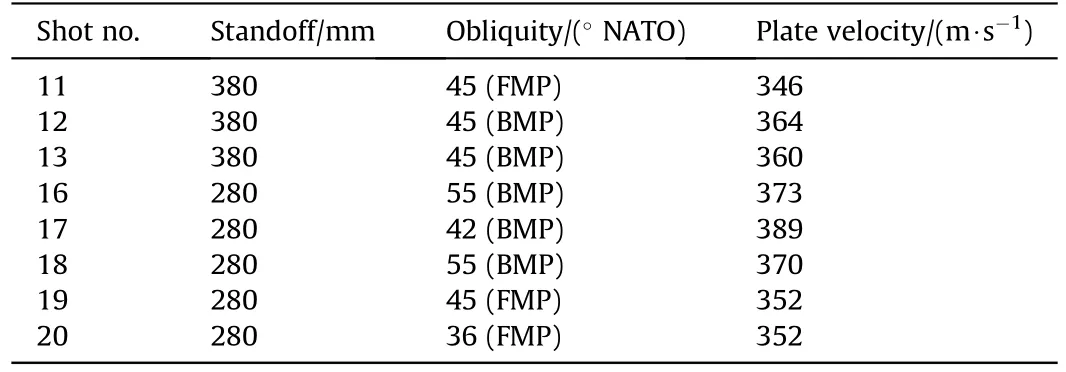
Table 1Test matrix.
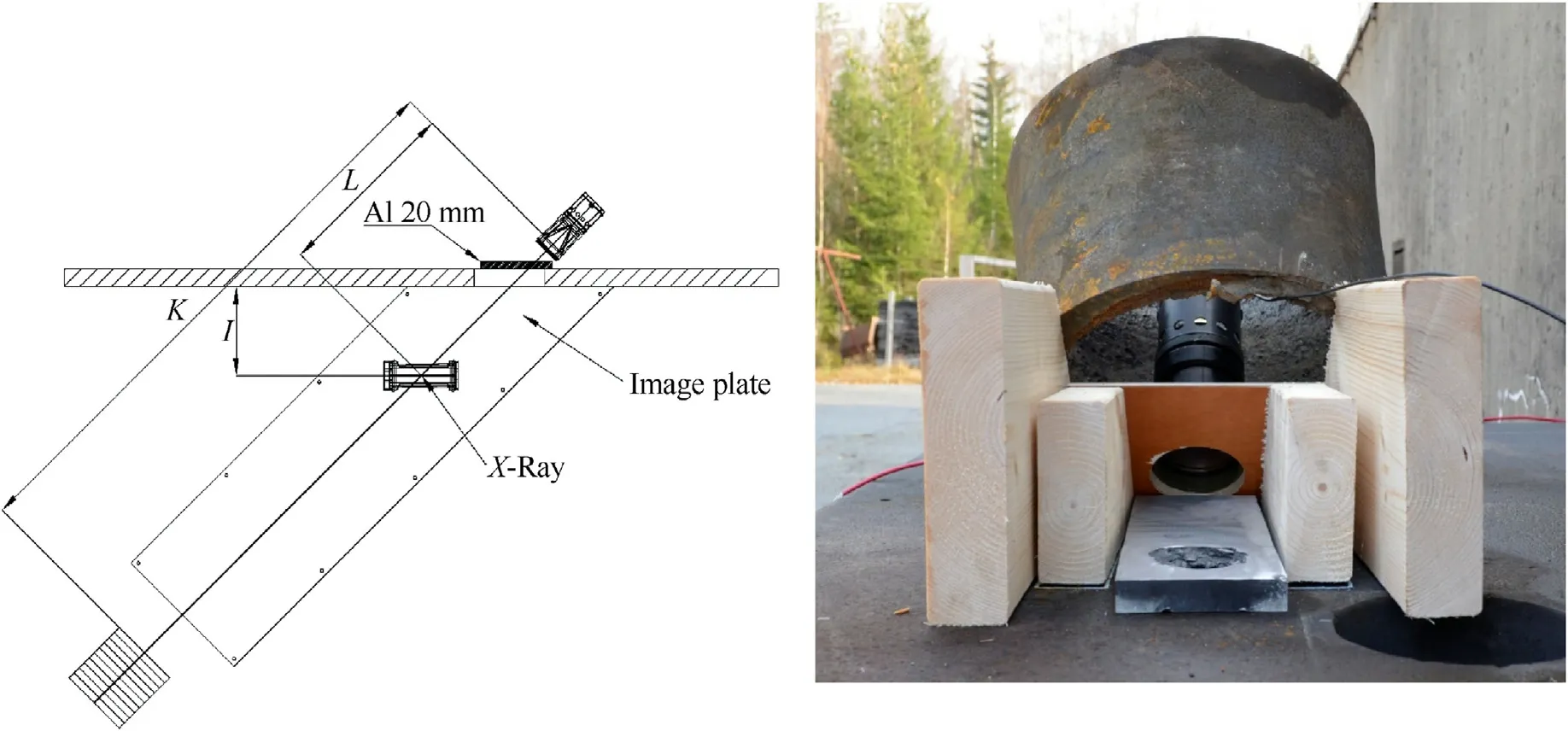
Fig.6.To the left, 2D-drawing of the firing rig.To the right, shaped charge warhead placed in wood cradle with an aluminium conditioning plate in front.

Fig.7.Radiographs of an undisturbed jet(shot 15)and jet after interacting with flyer plate(shots 11-13).The standoff distance between the charge(liner base)and the flyer plate was 380 mm in shots 11-13.Exposure times were 160 μs after initiation.Undisturbed jet at the top(shot 15),interaction with a BMP in the next two radiographs(shot 12-13)and interaction with a FMP in the last radiograph (shot 11).The jet is moving from left to right and the plate is moving obliquely upwards in the pictures.
A total of 20 shots were fired.In all cases, the nominal inclination were 45°but the obtained angles varied due to unwanted yaw of the projectile in some of the tests.Some of the shots were done without a shaped charge to test the triggering equipment and in some of the tests the triggering did not work as intended or the projectile collapsed during launch.The successful tests are presented in Table 1, together with the test conditions and the obtained plate velocities.
In shots 10 and 15, the projectile collapsed and the jet did not interact with the plate, which constitutes references of an undisturbed jet.
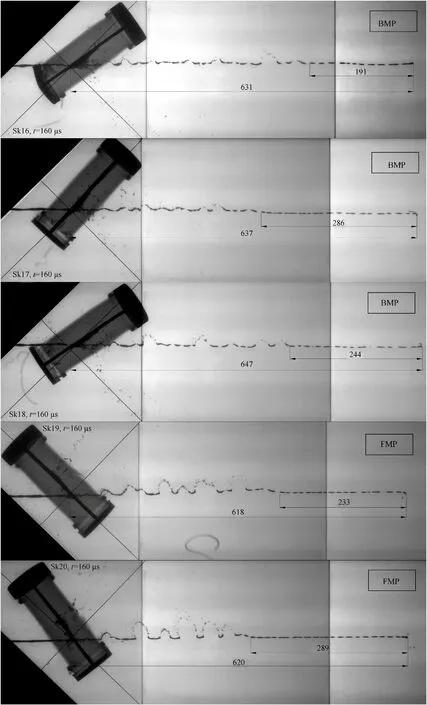
Fig.8.Radiographs of the jet after interacting with the flyer plate in shots 16-20.The standoff distance between the charge(liner base)and the plate was 280 mm for all five shots.Exposure time is 160 μs after detonation of the SC.Interaction with BMP in the first three radiographs and interaction with a FMP in the two radiographs furthest down.The jet is moving from left to right and the plate is moving obliquely upwards in the pictures.

Table 2Depth of penetration(DoP) in the different tests.Also included in the table are the lengths of the undisturbed parts of the leading jet(L) evaluated from the radiographs in Figs.7 and 8.In shot Nos.10 and 15, the jet did not interact with the plate and the penetration values are included as a reference for an undisturbed jet at this standoff.
2.2.1.Radiographsofthejetsafterplateinteraction
The results from tests with a 380 mm standoff are shown in Fig.7 together with the undisturbed jet from shot 15.It can be observed that the interaction with the forward moving plate starts much later than for the backwards moving plate but that the disturbances are stronger when the interaction does start.
The results from shots 16-20 with a standoff of 280 mm are presented in Fig.8.The trends are the same as in shots 11-13 with an undisturbed leading jet and larger disturbances on the rear of the jet for the FMP while the disturbances are smaller for the BMP.For the shorter standoff, an even longer part of the leading jet can pass through the crater before regaining contact with the crater wall on the FMP.
In some of the shots in this test series,there was notable yaw in the projectile resulting in a variation in inclination angle,from 36°to 55°(see Table 1),but this variation did not change the character of the interaction to any great extent.
2.2.2.Residualpenetration
An armour stack consisting of a number of 20 mm thick Armox 370T Class 2 steel plates was positioned at approximately 1.5 m from the charge.The penetration depths into the armour for all shots are presented in Table 2.The penetration depth is greater for shorter standoff to the flyer plate (shots 16-20) and experiments with FMP (shots 19-20) since a large part of the jet escaped undisturbed.In shot 11, the residual penetration is rather low even though the disturbances on the jet starts late.This might be due to the slightly misaligned jet tip seen in the radiograph in Fig.7 for this test.There is a natural large spread in penetration depth at this long distance to the armour stack, which explains the higher penetration depth in test 20 compared to tests 10 and 15 where the jet did not interact with the plate at all.
2.2.3.Photographsoftheflyerplates
Photographs of the flyer plates are shown in Fig.9.In all cases,a characteristic keyhole penetration channel is created from the impact and subsequent interaction between the jet and plate crater edge.The FMP creates pronounced wavy slits in the plates while the BMP slits looks more regular with only small ripples in the contact surface.The diameter of the entrance holes were around 17-18 mm in the all tests.
2.2.4.Analysisoftheprecursorjetlengths
The length of the precursor jet after interacting with flyer plates from an ERA has been studied in Ref.[17] where analytical expressions for the precursor length were derived.Those expressions cannot be used directly here since they assumes that the velocity vector of the plate is normal to its surface,which clearly is not the case here.A similar analysis can however be done for the present case using a virtual origin approximation.Based on the numerical results in subsection 3.2, it is assumed that appreciable transverse forces are transferred to the jet beginning when the jet first touch the mid plane of the crater wall.The approximate time from the impact of the plate to the start of the interaction isdt=(Rc-Rj/sin θ)/vpwhereRcis the crater radius,Rjis the jet radius, θ is the obliquity angle and vpis the plate velocity.UsingRc=9 mm,Rj=1 mm,θ=45°and vp=0.38 mm/μs we getdt=20 μs.
The first part of the jet that will touch the crater wall will have the velocity ve=S/(ti+dt) whereSis the standoff measured from the virtual origin(located 15 mm behind the liner base)andti=S/vtipis the time when the jet tip with velocity vtipimpacts the plate.The length of the precursor at timeti+dtis
where vjis the tip velocity after penetrating the plate.This formula is consistent with Eqs.(1) and (2) in Ref.[17] if all acceleration terms are omitted and the velocity transformations in Fig.2 from the lab-system to the collision point system are performed.The only difference is the term involving the jet radius which is not present in Ref.[17] and is due to differences in assumptions on when disturbances starts to develop on the jet.
The length of the precursor jet at the X-ray timetisL=(vj-ve)(t-t0)wheret0is the time of the virtual origin relative to the initiation time.Using vtip= 6.8 mm/μs, vj= 6.5 mm/μs,t=160 μs andt0=16 μs we arrive atL=286 mm for the 280 mm standoff andL=232 mm for the 380 mm standoff.These estimates should be compared to the measured lengths in the radiographs presented in subsubsection 2.2.1.The agreement is very good for the FMP-tests but overestimates the precursor length in most of the BMP-tests.The observed difference between FMP and BMP are discussed further in subsection 3.2.
3.Numerical simulations
Preliminary numerical 3D-simulations of the jet interaction with the flyer plate have been performed in order to test if hydrocode simulations can capture the difference in interaction with a FMP and BMP.The general-purpose software LS-DYNA R12.1 with a coupled Lagrangian-Eulerian approach was used for these simulations.The stretching jet was described by a Lagrange formulation and the plate by an Eulerian formulation.The main reason for using a mixed formulation is that a purely Eulerian formulation does not allow tangential velocity discontinuities between materials (like those that occur in a sliding contact) and that the plate will be subjected to very large deformations around the interaction region that can be difficult to handle with a Lagrangian formulation.The details of the simulation model is described in the next subsections.
3.1.Simulation model
3.1.1.Jetdescription
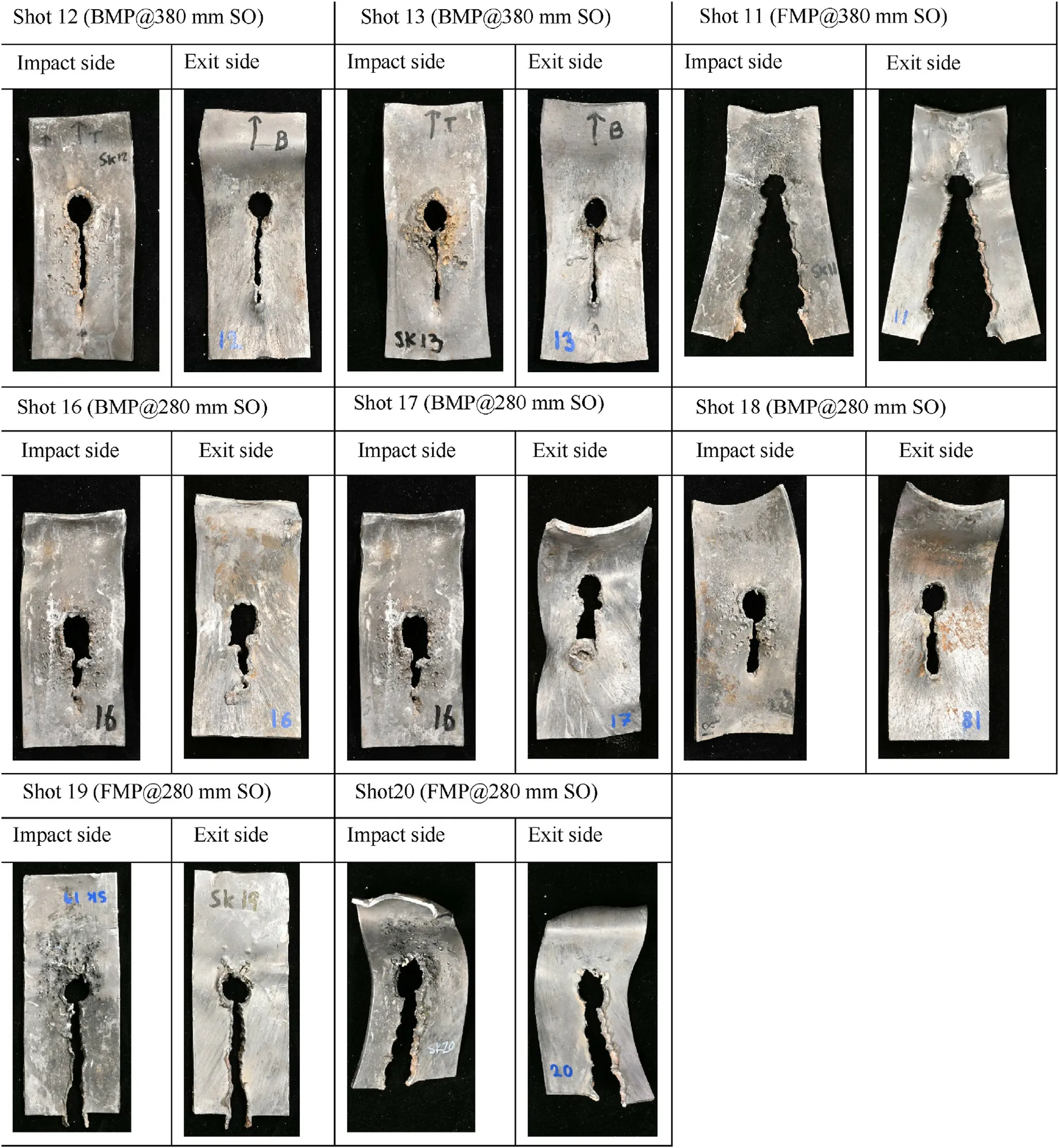
Fig.9.Photographs of the recovered flyer plates.

Table 3Johnson-Cook parameters for copper, data from Ref.[18].

Table 4Shear modulus and Mie-Grüneisen equation-of-state parameters for copper, data from Ref.[19].
The jet from the 84 mm-calibre charge used has been previously characterized using a combination of double exposed flash X-rays and 2D hydrocode simulations.From these pieces of data,analytical expressions for the jet velocity and radius vs axial position have been constructed at a reference time (55 μs after initiation).The analytical jet description at the reference time was used to reconstruct the 3D jet profile at a later time,just before the jet tip impacts the flyer plate.This geometry description together with appropriate initial conditions were used as input data for the 3D interaction simulations.The details of this reconstruction procedure and the choice of initial conditions are outline below.

Fig.10.Calculated shaped charge jet after penetrating a conditioning plate, 55 μs after initiation.Colours indicates jet velocity where red corresponds to 6800 m/s and blue corresponds to 0 m/s.
In the present study, the leading jet was removed by the presence of a conditioning plate in front of the charge.To take this into account, a new 2D hydrocode simulation of the jet formation and subsequent penetration of the conditioning plate was performed to describe the resulting jet tip velocity and shape.An in-house 2D multi-material Arbitrary Langrangian-Eulerian-code GRALE2D was used for these simulations.The thickness of the conditioning plate was adjusted to get the same line-of-sight thickness as in the experiments.A Johnson-Cook strength model and Mie-Grüneisen equation-of-state(EoS)was used to describe the copper liner with material parameters according to Tables 3 and 4.
The resulting jet at 55 μs is shown in Fig.10.The computed jet tip profile and velocity were combined with the previously determined jet data to determine a new analytical description for the complete jet.
The analytical expression for the jet radius vs axial position at the reference timet0= 55, were used to create an initial 3DLagrangian mesh for the jet.Mesh spacing was such that the elements should be approximately equilateral in the interaction region(thus progressively smaller further back on the jet).Ten elements were used along the diameter and the spacing along the axial direction varied from 0.2 mm in the tip to 0.08 mm in the tail for a total of 42 400 elements.
A Python script was used to calculate the initial velocity of each node and to create an output file that is used to initialize the node velocities in LS-DYNA.Another Python script was used to transform the nodal points to the positions corresponding to a timet1(just before the jet impacts the plate)using the formulas.
wheresis the Lagrangian coordinate defined as the jet mass-points axial position att=t0.
In some of the simulations, a small sinusoidal variation was superimposed on the radii to trigger necking and fragmentation of the jet that develops at later time.This was accomplished by using the transformation
where δ is the amplitude and λ is the wavelength of the perturbation.The perturbation amplitude and wavelength was selected such that approximately the correct number of fragments wascreated and the fragmentation time agreed with the experimentally determined values.For the charge used in these experiments,the wavelength λ=4 mm and amplitude δ=0.005 gave results that agreed well with experimental values.These values were used in the simulations with an initial sinusoidal variation.

Table 5Johnson-Cook material parameters for S355-J2 from Ref.[20].

Table 6Typical physical properties for low-alloy steels.Data for steel 4340 from Ref.[19].
The deformation hardening was assumed to be saturated after the jet formation.Therefore,an elastic-ideal-plastic material model was used, with a constant yield stress of 270 MPa.The same Mie-Grüneisen equation of state as for the 2D jet formation simulations was used in the 3D simulation.Element erosion was based on time step with a minimum time step of 1.0 ns.
3.1.2.Targetdescription
The plate was described by a structured multi-material ALE formulation (SALE in LS-DYNA) consisting of two materials, the plate and a vacuum region around the plate.A Johnson-Cook constitutive model coupled to a Mie-Grüneisen equation-of-state was used for the steel plate.The default behaviour of the Johnson-Cook failure model is that an element abruptly loose strength when the damage parameter reaches the value one,which can cause trouble in a multi-material ALE formulation.To avoid this,a user-defined implementation of the Johnson-Cook material model was used that incorporates a failure softening option.Using that option, the yield strength for partially damaged material is multiplied by an S-shaped function that depends on the damage variable.The softening function is one when the damage is below a critical damage valueDcrit, and reaches zero for fully damaged material.The material parameters used in the simulation were mainly taken from Ref.[20] and are listed in Tables 5 and 6.The element size in the SALE-mesh was 0.25 mm around the interaction zone and was coarsened outside the interaction zone.The SALEmesh consisted of around 2 million elements.
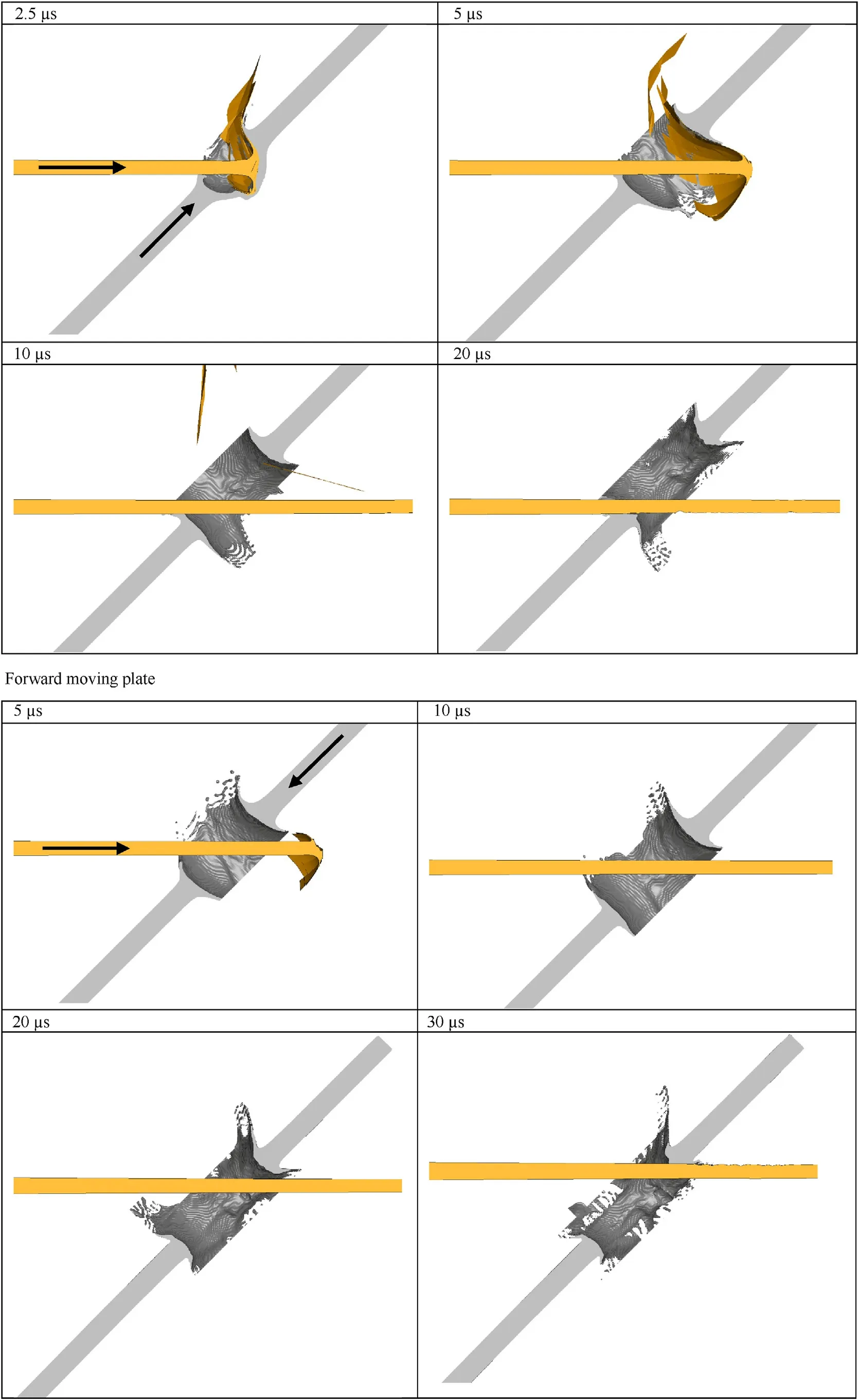
Fig.11.Detailed view of the jet (orange) penetrating the plate (grey) and the renewed contact between the jet and the plate crater for backward and forward moving plates respectively.

Fig.12.Contact pressure in the interaction zone during stable contact at t=70 μs.Smooth jet at 380 mm SO.Left,BMP,right FMP.The jet is moving from left to right.Red colour corresponds to 2 GPa and blue colour to -500 MPa.

Fig.13.Unstable contact between jet and FMP.Smooth jet at 380 mm SO.Four Lagrangian markers are added to the pictures in order to make it easier to follow the development of the disturbances.The jet velocity at the markers points are around 4000 m/s.

Fig.14.Comparison of jet shape from experiments (shot 11 & 13) and numerical simulations for 380 mm SO at 160 μs.Two different simulation results are included,one with initial perturbations (middle) and one without initial perturbations (above).

Fig.15.Comparison of jet shape from experiments (shot 17 & 19) and numerical simulations for 280 mm SO at 160 μs.Two different simulation results are included,one with initial perturbations (middle) and one without initial perturbations (above).
3.2.Simulation results
After the jet has penetrated the plate, there will be a delay before contact between the plate and the jet recurs.This time interval is very different for the BMP and FMP.As seen in Fig.11, it takes a much longer time for the FMP to regain contact with the jet,about 20-30 μs for the FMP compared to a few microseconds for the BMP.This difference is mainly due to asymmetries in crater expansion for oblique impact; 1) the distance from the jet to the crater wall will be larger up-streams than down-streams [17] and 2)the initial expansion of the crater differs on the impact and exit side.The BMP will first interact with the crater edge on the impact side that initially bends inwards while the FMP will first interact with the crater edge on the exit side that bends outwards, see Fig.11.
When the contact is re-established, more disturbances are observed on the jet after interacting with the FMP than after interacting with the BMP.The contact pressure has different characteristics for the two cases.Maximum pressure is established close to the collision point for the BMP,which pushes the jet away from the contact surface.For the FMP,the pressure increases gradually as a jet element enters the interaction zone and maximum contact pressure is obtained at the end of the interaction zone.The difference is illustrated in Fig.12.This difference seems to be an important factor for the stability of the contact.The snapshots from the simulation results in Fig.13 illustrate the development of a disturbance in the contact surface with a smooth jet interacting with a FMP at 380 mm standoff.During the same time interval,the contact between the jet and a BMP is completely stable (not shown).
The jet profile at 160 μs from numerical simulations with a smooth and a slightly wavy initial profile for the two standoffs are shown in Figs.14 and 15.It can be observed that the initially wavy jet is almost completely fragmented at 160 μs while the smooth jet has only small tendencies to fragmentation (except in those parts that have interacted with the plate).The wavy jet also creates larger disturbances than the smooth jet, especially notable at the greater standoff.Inclusion of a small waviness in the jet profile thus seems to be necessary to reproduce the experimental results.
4.Discussion and conclusions
Experiments have been performed where a plate was accelerated along its length,interacting with a shaped charge jet that was fired at an angle to the plate’s normal, either against or along the plate’s velocity.The arrangement corresponds to a jet interacting with a flyer plate from a reactive armour, with the exception that the collision velocity is the same for both types of obliquity in these experiments, while the collision velocities are different for a forward and backward moving plate(FMP and BMP) in a reactive armour.The experiments show that the disturbances on the jet are different in the two cases, even though the collision velocities are the same.Numerical simulations of the interaction supports this observation.The difference is attributed to the character of the contact pressure in the interaction region.For a BMP, the collision(stagnation) point is located at the beginning of the interaction zone while the collision (stagnation) point is located at the end of the interaction zone for a FMP and thus the contact pressure is higher downstream than upstream for an FMP.A negative interface pressure gradient with respect to the jet motion results in a more stable flow than a positive pressure gradient,which means that the jet-plate contact is more stable for a backward moving plate than for a forward moving plate.
In Ref.[5], a criterion for a stable contact based on mass fluxes was proposed.The analysis treated the interaction as an inelastic collision problem between the jet and the strip that is punched out from the flyer plate.Momentum conservation and energy considerations of the pre- and post-collision conditions resulted in a stability criterion solely based on mass fluxes of jet and strip.If the ratio of jet to strip mass flux is greater than one the contact is stable; otherwise, it is unstable.The present study shows that global mass flux is not the only determining factor for stability.How the mass flux is distributed in the interaction zone seems to be another important factor.It may be that a global mass flux ratio can constitute a necessary, but not sufficient, condition for a stable contact.The numerical simulations in Section 3 showed that the contact is mainly smooth for a smooth jet but small disturbances will amplify due to the high stagnation pressure that develops when the high-speed jet is decelerated by the plate material in front of the disturbance.The effect is stronger for a FMP for two reasons:the equilibrium contact pressure is low in the beginning of the contact region and there is more plate mass in front of an initially disturbed jet element.
Declaration of competing interest
The authors declare that they have no known competing financial interests or personal relationships that could have appeared to influence the work reported in this paper.
Acknowledgments
The program is funded by the Swedish Armed Forces under Contract No AT.9220620.
- Defence Technology的其它文章
- Machine learning for predicting the outcome of terminal ballistics events
- Fabrication and characterization of multi-scale coated boron powders with improved combustion performance: A brief review
- Experimental research on the launching system of auxiliary charge with filter cartridge structure
- Dependence of impact regime boundaries on the initial temperatures of projectiles and targets
- Experimental and numerical study of hypervelocity impact damage on composite overwrapped pressure vessels
- On the effect of pitch and yaw angles in oblique impacts of smallcaliber projectiles

